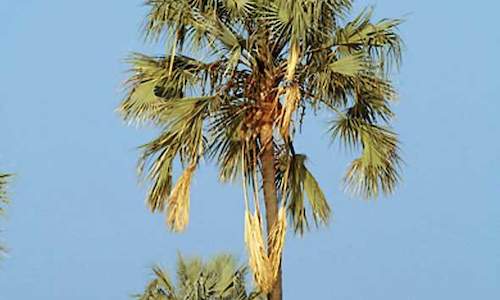
How observant are visitors to the Kruger National Park? It is certain that the vast majority of visitors to the park have their eyes peeled for lions, leopards, and other 'big and hairies', and the birdwatchers are always alert for the flash of sunlight on a wing, but how many people stop and really look at the trees that grow in the park?
If tree-spotters ever intently scrutinised some of the large trees that grow near tourist roads, they might be surprised to discover a large ring of rocks around the base of the tree's trunk. These rocks were placed around the trees in the late 1970s, when Tol Pienaar was warden of the park, with the intention of keeping elephants away from some of the more magnificent specimens.
This was not just to benefit the tourists, but because old bull elephants also like to walk tourist roads, which provide a nice, stable place to engage in a spot of tree-tussling. Once a special tree was identified, the workers in the section would collect rocks in idle times and pack them around the base of the tree.Pienaar recalls that to be effective, the ring of rock had to be between four and five metres across, to prevent elephants from reaching the tree's stem with their trunks. The elephants were reluctant to step on the rocks, especially when they shifted underfoot, but could still topple a tree if they could grasp it well enough with their trunks.
As time passed, grasses and other plants grew up in between the rocks, and the base of the tree would look little different from its surroundings. However, in severe drought times the rocks would show through more prominently. District ranger Louis Olivier distinctly recalls packing rocks around the ilala palm outside Shingwedzi, especially the times when the rocks demanded a sacrifice of skin off his hands. He says that another anti-elephant device that was tried at the time was an extract of khakibos.Along with Shingwedzi's ilala palm, a number of marulas near Nwanetsi received rock skirts. Other trees protected in this way included baobabs and some umbrella thorns near the Timbavati River. Some of the trees have been damaged by elephants despite the rocks, but some, like the ilala palm, still stand tall and proud.
With the passage of time, no one has an exact knowledge of how many trees were protected with rocks. With this season's good rains, spotting the rocks will be even more of a challenge for tourists this year as the vegetation under the trees will be particularly lush.

 Locally called Molala, large palm trees usually 5 to 7m, but sometimes up to 15m in height, single or multi-stemmed, with a slight swelling ...
Locally called Molala, large palm trees usually 5 to 7m, but sometimes up to 15m in height, single or multi-stemmed, with a slight swelling ...